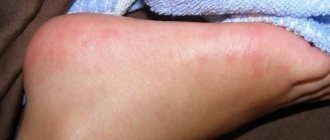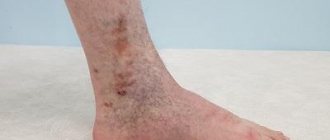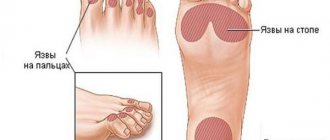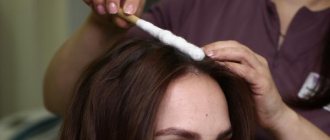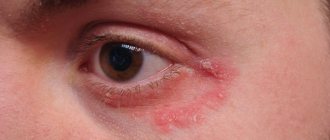Eczema is a chronic skin disease that is accompanied by the appearance of vesicular rashes on the skin. These are small blisters filled with serous fluid. This is exactly how weeping eczema occurs. With the dry form, there is increased dryness of the hands, peeling and cracks. Treatment of weeping eczema has different principles, since the symptoms differ from those observed with the dry type.
Causes of weeping eczema
The exact cause of eczema is unknown, but the development of the disease is influenced by genetic predisposition, the presence of predisposing changes in the functioning of the immune system, allergic predisposition, functional changes in the nervous, endocrine and digestive systems.
Provoking factors may include:
- hereditary predisposition;
- hyperthyroidism;
- diabetes;
- bronchial asthma;
- exudative diathesis;
- changes in hormonal levels;
- ulcers, gastritis and other diseases of the digestive system;
- diseases of the nervous system;
- chronic infections;
- stressful situations;
- allergies to food or medications;
- physical and emotional stress;
- prolonged depression;
- constant contact with chemicals.
The pathology can affect people of all ages, and children are no exception.
Eczema: causes
The main reason is immunity disorders and factors that have a depressing and destructive effect on the protective function of the skin. As a result of disruption of the immune system, the body begins to react “inappropriately” to various external stimuli. Accordingly, the causes of eczema on the hands, for example, are detergents (even soap) or cosmetics (perfumes, creams, etc.).
Also “provoking” factors include:
- hereditary predisposition;
- allergic reactions to certain external influences;
- psychosomatic reactions;
- disturbances in the functioning of the endocrine and nervous systems;
- improper functioning of the digestive system;
- external factors, etc.
Only an experienced specialist should determine the causes of eczema on the palms or hands, on the head behind the ears or on the face, in order to then prescribe an effective course of therapeutic and restorative therapy. At the first sign, it is better not to delay visiting a doctor.
Eczema: treatment (on the arms, legs, behind the ears, etc.)
The difficulty of treatment lies not only in the fact that the disease can be chronic, but also in the fact that it affects even the deep layers of the skin. Fast and effective treatment (with the prevention of relapses) is possible only with timely consultation with a doctor. a dermatovenerologist knows how and how to treat eczema on the arms, legs and other parts of the body.
. Self-medication can lead to increased skin lesions and serious complications.
Initial appointment
As a rule, at the initial appointment, the doctor immediately diagnoses eczema by simply examining the patient. During the examination, the locations of eczema lesions are also recorded (on the palms, face, neck, head, behind the ear, etc.), which makes it possible to determine the cause. Examination, examination of tests and complaints, assignment of studies for each specific clinical case are individual.
If eczema is mild, then at the first consultation the doctor will prescribe treatment, its timing and subsequent visits for monitoring. If the disease is more complex, the doctor may prescribe additional tests and examinations.
Diagnostics
General parameters for diagnosing eczema of different types (plaque, atomic, infectious, etc.):
- detailed clinical and laboratory studies to identify pathologies of internal organs;
- analyzes and studies of the functioning of the endocrine and cardiovascular systems;
- analysis for helminthic infestations;
- mycological studies.
When you know why eczema appears, it becomes clear how and with what to treat it. When prescribing a course, the doctor also takes into account the medical history (if this is not a primary infection) and the individual characteristics of the patient in order to cure eczema as quickly as possible.
Repeated appointment
This is a visit to the doctor after undergoing all examinations and tests, as well as the selection of a treatment regimen based on the results of the examinations.
A repeat appointment is also scheduled after completing the course, so that the doctor can make sure that the chosen regimen is effective. If no positive dynamics are observed, then other medications are selected and the course of treatment is adjusted. Additional examinations are possible.
Treatment of weeping or dry, microbial, allergic and varicose, plaque or coin-shaped eczema: general parameters
One of the basic rules during treatment and during periods of exacerbation is to minimize the patient’s contact with water.
As an external treatment, the doctor can prescribe various lotions and compresses to the affected areas and treat the blisters after opening with special ointments and agents. Also, for eczema, a hypoallergenic diet is necessarily indicated.
Control reception
At the initial appointment, the doctor determines the time of the follow-up visit in order to assess the patient’s health status and, if necessary, develop a plan for restorative therapy and rehabilitation after treatment.
As a rule, all measures are aimed at restoring and strengthening the immune system. The doctor already knows why eczema appears in each individual case, where the blisters appear (on the hands or face), in what form (dyshidrotic, microbial, etc.), how and with what to treat and how to recover after treatment.
Treatment results
The disease can be cured, but the timing is always strictly individual. All details are discussed at the doctor’s appointment. Also, if necessary, treatment for other existing diseases that are provoking factors for eczema is prescribed in parallel.
Prevention
To prevent eczema, diet and proper skin care are prescribed, as well as various measures to strengthen the immune system (for example, hardening) and to minimize the causes of relapses.
If possible, it is necessary to exclude any contact with allergens that cause illness, both at home and at work. It is recommended to wear clothes made from natural materials. If a relapse of eczema does occur and an exacerbation begins, then you need to consult a doctor and limit contact with water, soap and other household products.
The medical clinic provides comprehensive diagnosis and treatment of skin diseases, including eczema (wet, dry, microbial, chronic, on the lower leg or behind the ear) using various means and methods. You can make an appointment with a doctor by calling the phone number listed at the top right, or through the website using a special form.
Symptoms of weeping eczema
In the photo of weeping (dyshidrotic) eczema, signs of the disease are clearly visible. A characteristic symptom of weeping (dyshidrotic) eczema is the simultaneous presence of a rash at various stages of development. Initially, red, swollen spots appear on the skin, later papules with purulent contents and vesicles filled with serous exudate form on their surface. As a result of scratching or on their own, the bubbles open, forming weeping areas on which the exudate is located pointwise, resembling dew drops. Over time, the liquid dries out, forming a peeling crust.
The disease is accompanied by very severe itching, which causes insomnia, irritability and nervousness, and sometimes even leads to reversible mental disorders.
When the disease becomes chronic, the skin turns bluish-reddish and thickens. Often, stagnant spots at the site of the most pronounced rashes and peeling do not disappear even during the period of remission.
A dermatologist can make a diagnosis based on an external examination. To determine the cause of the problem, immunological, allergic and scarification tests are performed.
Eczema: what is it?
This is an inflammatory skin disease, which is non-infectious and occurs quite often in adults and children. The disease has a number of pronounced symptoms. Acutely manifesting itself at the very beginning, without proper treatment it becomes chronic, the main symptom of which is frequent relapses.
The localization of the disease varies: most often, eczema occurs on the hands and feet, affecting the area between the fingers or the entire hand and foot. But the appearance of redness and peeling is also possible in other areas: on the head (behind the ears), on the body (especially in the folds), etc.
One of the frequently asked questions to doctors is whether eczema is contagious or not?
The fact that eczema is not transmitted from person to person is an established fact, so formally there is no reason to fear infection. But it is worth keeping in mind that many infectious skin diseases are similar in appearance to eczema. Therefore, it is recommended to undergo diagnostics from specialists.
At the Energo medical clinic, dermatovenerologists provide professional medical care, relieving patients of an unpleasant disease. During treatment, the patient is given maximum attention in order to improve his quality of life as quickly as possible.
Consequences of eczema
Eczema is accompanied by severe itching, sometimes unbearable. You should not scratch the affected areas, otherwise this can lead to complications in the form of infection, as well as to longer treatment of the eczema itself. Also, disturbing itching can lead to sleep disturbances (including insomnia) and the development of neurotic disorders.
With seborrheic eczema, a common complication is inflammation of the eyelids, which is accompanied by redness and swelling of the eyes for a long time and the formation of cracks in the outer corners of the eyes.
Treatment of weeping eczema
How to treat weeping eczema? To cope with the disease, you will need complex treatment, which includes both medication and therapeutic techniques.
Drug treatment involves the use of both systemic and local drugs.
It allows:
- reduce sensitivity to allergic substances;
- relieve inflammation;
- reduce body intoxication;
Usually the doctor prescribes:
- external anti-inflammatory drugs
- antihistamines with a sedative (calming) effect - eliminate itching, burning, swelling, inflammation and other unpleasant symptoms;
- enterosorbents – absorb and remove toxic substances;
- immunomodulatory agents – strengthen the immune system;
- vitamin complexes.
In addition to symptomatic medications, general remedies aimed at eliminating the cause of the disease will also be needed.
The focus is on topical treatment of weeping eczema. During periods of exacerbation, hormonal drugs and traditional drying agents based on naphthalan and tar, cold compresses from chamomile decoction or oak bark are recommended. Drying agents are prescribed for a short period of time until all the bubbles disappear.
Hormonal drugs provide quick and effective results, but can cause addiction with prolonged use and other undesirable effects, including thinning of the skin. Usually they are used for no more than 2-3 weeks.
After relieving acute symptoms, you will need non-hormonal ointments that have a restorative and exfoliating effect and can prolong remission.
Also during this period you can carry out physiotherapeutic procedures:
- acupuncture;
- ultra-high frequency therapy;
- ultraviolet irradiation;
- ozone therapy;
- phonophoresis;
- laser therapy;
- cryotherapy;
- magnetic therapy;
- phototherapy;
- thalassotherapy;
- paraffin treatment;
- mud therapy.
In addition to taking medications and using ointments, it is necessary to change your lifestyle: eliminate bad habits, walk in the fresh air more often and stick to a diet. You will have to give up smoked meats, fatty, salty and spicy foods, pasta, eggs, seafood, citrus fruits (as well as fruits colored red), strawberries, raspberries, chocolate, honey, coffee, tea, sweet carbonated drinks, and limit the consumption of potatoes . At the same time, it is necessary to provide the body with adequate nutrition and provide it with all the necessary vitamins and minerals.
You should not wait for a complete recovery, as this process is chronic. But if you strictly follow the doctor’s recommendations, you will be able to achieve stable remission and avoid exacerbations.
An effective treatment regimen for wet eczema to achieve remission
Before treating weeping eczema, the patient is prescribed a comprehensive examination, although experienced PsorMak specialists diagnose the disease quickly enough based on external signs. A scraping is taken from the affected area to detect fungus or bacteria that may be causing the pathology.
Treatment of wet eczema involves local action directly on the foci of inflammation. At the same time, comprehensive and adequate care for damaged skin is provided, as well as prevention of secondary infections. The PsorMak clinic has been practicing its own treatment regimen for more than 25 years, including:
- Local application of natural ointment prepared according to the clinic’s own recipe from natural ingredients, without a hormonal component.
- A course of acupuncture, which has a general strengthening effect and affects biologically active points of the human body.
- Hirudotherapy course.
- Working with a psychotherapist who helps get rid of possible psychological causes of the disease.
Treatment of weeping eczema on the hands or other parts of the body is carried out not only during the period of exacerbation. During remission, to prevent relapses, the doctor prescribes a diet and gives recommendations regarding lifestyle. From here it is easy to understand that the help of a dermatologist is required both during an exacerbation and during a period of remission.
At the PsorMak clinic, you can see the best specialists who have extensive work experience and have undergone internships abroad. Understanding that the results are the most important in treatment, we present them in the appropriate section. Our proprietary therapy program has already helped hundreds of patients, which you can easily verify after your first appointment.
Zinc-naphthalan paste Losterin for weeping (dyshidrotic) eczema
One of the effective remedies in the treatment of the acute stage of weeping (dyshidrotic) eczema is zinc-naphthalan paste Losterin. It has a drying and adsorbing effect, relieves itching, reduces the inflammatory component and prevents the development of secondary infection.
The composition of Losterin paste includes deresined naphthalan (3%) and zinc oxide (25%). The paste does not contain hormones and does not cause withdrawal symptoms or other unwanted complications. Therefore, it can be used daily (usually 3 to 10 days)
Prevention of weeping (dyshidrotic) eczema
To prevent relapses, it is recommended:
- “forget” about bad habits;
- avoid contact with allergens;
- maintain the correct daily routine, take time for proper sleep;
- stick to a diet;
- eliminate nervous stress;
- avoid stressful situations;
- avoid visiting bathhouses, saunas and other places where exposure to water and high temperatures is combined;
- do not overheat or overcool the body;
- wear cotton clothes;
- timely treat various diseases;
Maintaining body hygiene is especially important. But you should not use hygiene products containing alkalis and chemical fragrances, as they can provoke an exacerbation. It is best to purchase hypoallergenic products from the Losterin series (shampoo, shower gel and cream soap). They do not irritate the skin and are recommended for daily use.
Bibliography
- Ado A.D. General allergology. M.; "Medicine", 1970.-543 p.
- Alekseeva, O.G. On the methodology for determining the allergenic properties of chemical substances / O.G. Alekseeva, A.I. Petkevich // Hygiene and sanitation. 1973. - No. 3. — P. 64-67.
- Belousova, T.A. Dermatophytosis (skin mycoses) is an urgent problem of modern dermatology. Electronic resource. // Russian medical journal. 2003. No. 17. - Access mode: https://www.dennatolog4vou.rn/stat/rmi/dermatofitii act probl.html, - Cap. from the screen.
- Zheltakov M.M. Issues of allergy in dermatology // Bulletin of Dermatology and Venereology.-1962.- No. 9.- p. 3.
- Zibitsker D.E. Bacterial and drug allergies. Minsk, “Belarus”, 1996.- 223 p.
- Kamyshnikov, BC What do medical tests say: A reference guide / BC Kamyshnikov. Minsk: Belarusian Science, - 1997. - 189 p.
- Chernukh AM Frolov E.P. Inflammation of the skin // Skin.-M.: Medicine, 1982.-p.193-230.
- Shaternikov V.A., Konyshev V.A., Mazo V.K. Structure and properties of food allergens // Nutrition Issues. - 1980. - No. 1. - S.Z.



